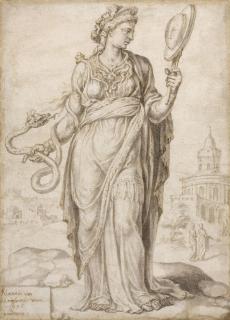


The artist was named Heemskerck after the village in which he was born in 1498, the son of Jacob Willemsz. van Veen. His apprenticeship began under Cornelis Willemsz. in Haarlem and continued under Jan Lucasz. in Delft. At the end of the 1520s, when he learnt that Jan van Scorel, who had developed a new style of painting in Italy, had settled in Haarlem, he went to work with him. In 1532, Heemskerck travelled to Rome, where he stayed until the end of 1536. There he made a few paintings with mythological subjects and especially pen drawings after ancient sculpture and architecture, which testify to his great interest and admiration for the classical past. After his return to Holland, he once again settled in Haarlem, where he remained until his death. Only during the Siege of Haarlem in 1572 did he take refuge in another city, Amsterdam. We are well informed about his personal life and the fact that his art made him a rich and powerful man. Socially he was part of the upper circles of Haarlem society and mixed with magistrates, scholars and notables.
In this drawing, made with pen and brush, with grey-brown washes and heightened with a pink bodycolour – a rare technique for van Heemskerck, we see a tall woman standing in a classical landscape. She is two-headed: on the front she has the face of a young woman, but on the back of her head is the face of a bearded man. She holds a mirror in her left hand, upon which her reflected image is visible, and a snake is curled over her right arm. She therefore represents Prudence (Prudencia), just as the artist has indicated on a little tablet in the bottom left corner, along with his name and the date, 1556. The snake is a reference to Matthew 10:16, ‘Be ye therefore wise as serpents.’ The mirror provides a faithful reflection and is the symbol for wise insight, and it also refers to self-knowledge and prudence. Her double face is also a typical attribute for Prudence; the front with the face of a woman looks into the future, while the man’s face on the back of the head looks to the past.
This drawing belongs to a series of the Seven Virtues. Fortitude and Temperance are presently in the Lugt Collection in Paris. The Lugt Collection drawings are likewise heightened with pink bodycolour and are a bit larger (29.6 x 21. cm) than the sheet in the A. G. Leventis Collection. Two other drawings from the series, Faith and Justice, are in the Städelsches Kunstinstitut in Frankfurt. These drawings are even larger ( 0 x 21.7 cm and 0 x 21.8 cm), and the figures have even more space above their heads. Prudence originally would have had the same measurements. The drawing has been cut at the top, and also the lettering on the tablet on the bottom left would originally have had more space on the outer edge. The watermark in the paper is identical to the one in the paper on which Temperance in Paris was drawn. Although nothing is known about the provenance of the drawings before they were acquired by their present owners, I would propose that the series of five surviving drawings formed part of an auction in 1802 in Amsterdam, where on 22 March ‘Zes stuks [tekeningen] Prudentia, Fortitudo, Pax, Fides, Temperancia en Patientia, met de pen en O.I. Inkt, door M. Heemskerck’ were sold
Although we would expect that the drawings were designs for a series of engravings of the Seven Virtues, this is not the case. Not a single print after one of the designs is known. Rather, as Karel Boon suggested, they were probably intended as designs for a series of grisailles or paintings. From Maerten van Heemskerck’s hand several (incomplete) series with grisailles are known, among others those in the Rijksmuseum in Amsterdam. It is therefore very possible that this series of drawings was also made with such a purpose in mind.
In the late 1520s he entered the workshop of Jan van Scorel, whose Italian-influenced style he adopted. His stay in Rome (1532-1536) furthered this direction, and his works express his appreciation for classical antiquity. After his return to the Netherlands, he settled in Haarlem, where he acquired a high reputation as a painter of altarpieces and portraits. His art made him wealthy and influential. He was also amongst the first artists to make drawings explicitly for commercial reproduction by engravers.